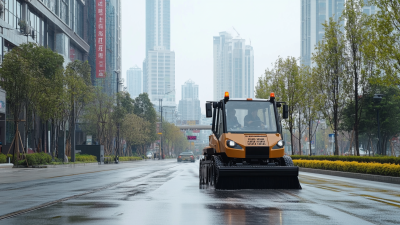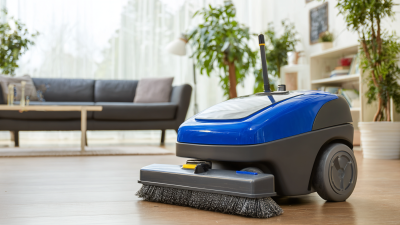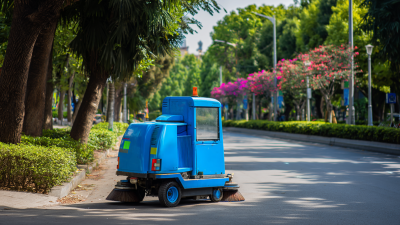Leave Your Message
In the rapidly evolving urban landscape, maintaining cleanliness is paramount for the health and aesthetic appeal of city environments. The introduction of innovative solutions, such as the Street Vacuum Cleaner, has revolutionized how municipalities approach street cleaning. According to Dr. Mark Thompson, a leading expert in urban sanitation, “The utilization of advanced street vacuum cleaners not only enhances the efficiency of urban cleaning operations but also significantly reduces the environmental footprint of waste management.” This sentiment underscores the importance of adopting modern cleaning technologies to tackle urban litter and debris effectively.

Street vacuum cleaners are specifically designed to navigate the complexities of urban environments, offering a myriad of benefits that extend beyond traditional cleaning methods. From improved air quality to enhanced public safety, these machines play a crucial role in creating cleaner and more sustainable cities. As cities continue to grow, the demand for efficient street cleaning solutions like the Street Vacuum Cleaner will only increase, highlighting the need for municipalities to invest in technologies that promote cleanliness and environmental stewardship. Embracing this innovation can lead to not only cleaner streets but also a more engaged and healthier community.
 Street vacuum cleaners have revolutionized urban cleaning by significantly boosting efficiency in maintaining public spaces.
These advanced machines are designed to tackle debris, leaves, and litter with ease, allowing municipalities to keep city streets clean while saving time and labor costs.
Unlike traditional cleaning methods, street vacuum cleaners can cover larger areas in a shorter period, reducing the need for multiple workers and equipment.
Their powerful suction capability ensures that fine dust and smaller particles are collected, contributing to improved air quality in urban environments.
Street vacuum cleaners have revolutionized urban cleaning by significantly boosting efficiency in maintaining public spaces.
These advanced machines are designed to tackle debris, leaves, and litter with ease, allowing municipalities to keep city streets clean while saving time and labor costs.
Unlike traditional cleaning methods, street vacuum cleaners can cover larger areas in a shorter period, reducing the need for multiple workers and equipment.
Their powerful suction capability ensures that fine dust and smaller particles are collected, contributing to improved air quality in urban environments.
When using street vacuum cleaners, it's essential to optimize their effectiveness. One tip is to schedule cleaning during off-peak hours to minimize disruption and ensure thorough cleaning without the interference of traffic. Additionally, regular maintenance of the vacuum cleaner is crucial; checking filters and suction power can prevent downtime and enhance performance. Another helpful tip is to train operators on the specific capabilities and best practices for using the equipment, as well as understanding the different terrains and street conditions they may encounter to maximize cleaning efficiency.
Street vacuum cleaners play a crucial role in enhancing air quality in urban environments. By efficiently collecting debris, dust, and pollutants from streets and sidewalks, these machines help mitigate the harmful effects of airborne particles. As cities grow, so does the burden of dust and litter that contribute to poor air quality — street vacuum cleaners serve as an effective solution to this pervasive problem. Their operation reduces the amount of particulate matter that can easily become airborne, particularly during dry conditions or strong winds, leading to cleaner air for everyone in the vicinity.
When considering the adoption of street vacuum cleaners, municipalities should focus on regular maintenance and optimal usage practices. Tips for maximizing their effectiveness include scheduling frequent cleanings during peak pollination periods and aligning operations with times of less traffic to minimize disruption. Additionally, operators should be trained in the latest technologies and techniques for efficient debris collection, ensuring that they can tackle the unique challenges of urban environments.
Investing in high-quality filters for the vacuum cleaners can further trap fine particles, enhancing the overall air quality and contributing to a healthier community.
Street vacuum cleaners have emerged as a pivotal tool in the pursuit of
sustainable urban management. Their eco-friendly designs significantly contribute to
efficient solid waste management while minimizing environmental impact. According to a market research report by
Custom Market Insights, the global commercial cleaning services market is projected to reach USD 443.23 billion
by 2033, with an impressive CAGR of 6.7%. This growth underscores the increasing focus on cleanliness
and sustainability in urban landscapes as cities strive to enhance ecological design and functionality.
Utilizing street vacuum cleaners not only helps maintain clean streets but also supports broader sustainable practices.
They reduce noise pollution compared to traditional cleaning methods and utilize less
water and chemicals, leading to improved air quality. For urban planners and municipal services, investing in advanced street
cleaning technology aligns with the growing emphasis on green infrastructure.
Tips for Effective Urban Cleaning:

Street vacuum cleaners are becoming increasingly popular in urban areas, and for good reason. One of the most significant advantages of using these machines is their cost-effectiveness, leading to substantial long-term savings for municipalities. A study by the International Journal of Urban Cleanliness suggests that cities that implement street vacuum cleaning systems can reduce litter management costs by up to 30%. This reduction stems from improved operational efficiency and decreased need for manual litter collection methods.
Moreover, street vacuum cleaners contribute to lower fuel expenditures over time. According to the Environmental Protection Agency (EPA), modern street vacuum systems utilize advanced technology that enhances fuel efficiency, saving cities approximately 20% on fuel costs compared to traditional cleaning methods. This not only results in financial savings but also leads to reduced carbon emissions, aligning with environmental sustainability goals.
Tips for maximizing the cost-effectiveness of street vacuum cleaners include scheduling regular cleaning routes to minimize the need for emergency clean-ups, which often incur higher costs. Additionally, investing in high-quality street vacuum systems may involve higher initial expenditures but often pays off through reduced maintenance costs and increased reliability over time. Lastly, consider cross-training staff to operate these machines, allowing for more flexible and efficient workforce allocation.
Urban cleaning plays a crucial role in enhancing public health and safety. Regular use of street vacuum cleaners significantly contributes to maintaining a clean environment by effectively removing debris, pollutants, and waste from city streets. This proactive approach not only minimizes visual clutter but also reduces the likelihood of air pollution. Clean streets can lead to a decrease in harmful particulates, ensuring healthier air quality for residents, especially in densely populated urban areas where the risk of respiratory ailments is heightened.
Moreover, a clean urban environment fosters safer spaces for community activities. Unsightly litter and pollutants can deter physical activity and outdoor engagement. By maintaining orderly and hygienic streets, communities become more inviting for walking, cycling, and other forms of exercise. A cleaner city not only enhances aesthetic appeal but also promotes mental and emotional well-being, as people are more likely to engage in physical activity in safe, appealing environments. Ultimately, integrating street vacuum cleaners into regular urban maintenance strategies supports both environmental health and community wellness, emphasizing the interconnectedness of cleanliness, safety, and the quality of urban life.
| Benefit | Description | Impact on Public Health |
|---|---|---|
| Improved Air Quality | Reduces dust and particulate matter in the air. | Lowers respiratory problems. |
| Enhanced Aesthetic Appeal | Keeps streets clean and visually appealing. | Encourages community pride. |
| Reduced Risk of Accidents | Eliminates debris that can cause slips or falls. | Decreases injury rates. |
| Lower Pest Populations | Removes waste that attracts pests. | Reduces disease transmission. |
| Increased Operational Efficiency | Cleans large areas quickly and effectively. | Enhances urban maintenance efforts. |
| Cost-Effective | Reduces manual labor and maintenance costs. | Allocates budget to health programs. |
| Regular Maintenance | Facilitates routine cleaning schedules. | Maintains city hygiene standards. |
| Community Engagement | Promotes local participation in cleanliness initiatives. | Fosters a collaborative environment. |
| Sustainability | Utilizes eco-friendly technologies. | Supports long-term environmental health. |
| Adaptability | Effective in various urban environments and surfaces. | Enhances overall urban safety. |






